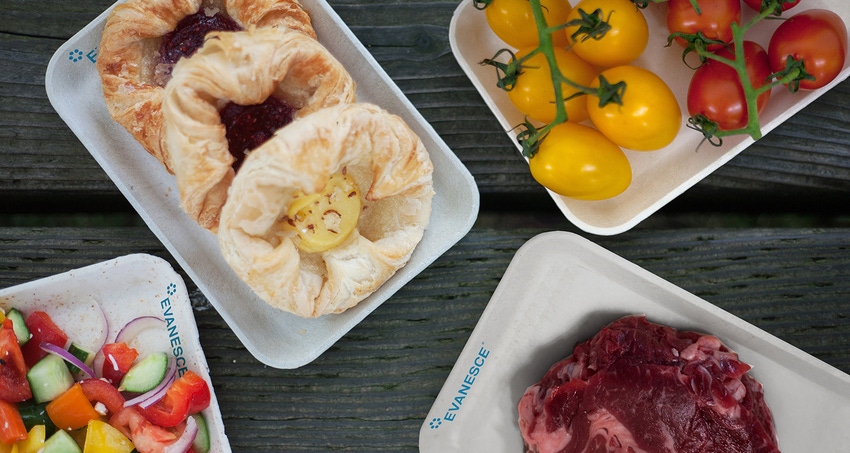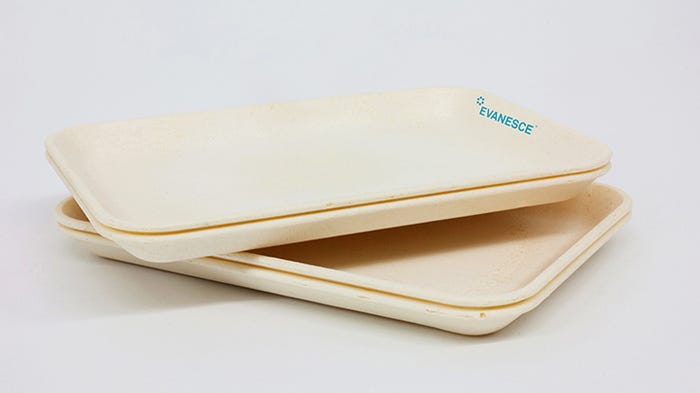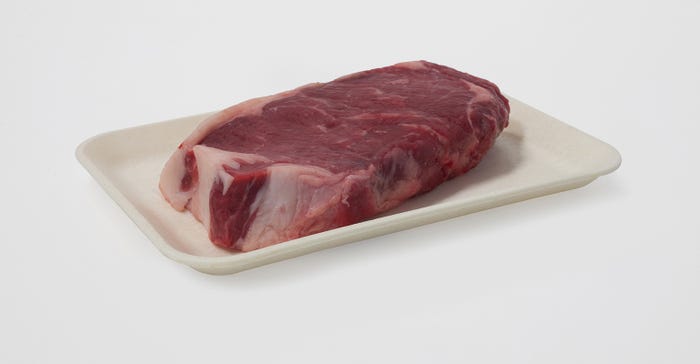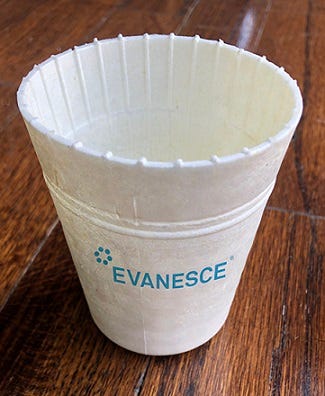Sustainable Packaging That's Baked to Compostable Perfection
Evanesce’s durable food trays made from starch and fiber are "baked like a cookie” and home compostable in 90 days.
September 29, 2021

A dough made from starch, fiber, and little else that’s baked into compostable packaging using Evanesce Packaging Solutions’s patented technology is a breakthrough recipe for sustainable packaging.
Company founder Douglas Horne was an elected government official in British Columbia, Canada, when he came across the technology. It so profoundly changed his way of thinking about packaging that it prompted Horne to change careers.
“At that time, I felt that we should ban expanded polystyrene (EPS) packaging because of this elegant alternative solution,” he relates. “The technology is so fantastic I left politics to acquire it then surrounded myself with great people to take it to a commercial level. One of the things that always worried me as a regulator was the fact that many of the products that were considered sustainable weren’t. This is.”
The packaging is a molded starch-and-fiber product uniquely different than anything else including thermoformed fiber products, according to Horne. “It looks and feels like a traditional thermoformed plastic tray."
The word evanesce means to disappear. “That defines the company and our product: Evanesce Molded Starch technology is the essence of what we do,” he explains.
We unpack the technology as highlights Horne provided in a recent interview.
Competitively priced sustainable packaging.
Brands, retailers, and consumers are looking for more sustainable options at a competitive price.
“EPS and other plastics have done so well in the market is because they're inexpensive, versatile, and can be made into many shapes and forms,” says Horne. “Our products are comparable, though perhaps slightly higher in cost because of the value-added attributes.”

The recipe allows for variable ingredients that determine how it looks.
A dough is created from a mix of 60% starch, 35% fiber, and 5% other ingredients that Horne indicates is the “secret sauce” that makes this work.
The blend keeps costs low because starch is significantly less expensive than fiber, he says.
“Another exciting aspect of the technology is that the starch and fiber don’t have to come from a specific source,” Horne divulges. “The ingredients are a variable supply-and-demand factor to further keep costs low by using the cheapest available fiber source.”
A summary of the specific recipe options:
Different starches may be used, such as tapioca, potato, and others.
Different fiber sources may be used that are often considered waste from food production operations, for example, bagasse or rice husks.
The product color can be a white like a standard EPS or gray or look like a brownie, depending on what type of fiber is used.
Dyes could also be used to adjust the color.
The packaging is baked like a cookie.
The technology adapts standard food processing equipment.
“We’re taking technology that's been around for years and adapting it to use a different dough for making packaging,” says Horne. “The dough is formed by a ‘waffle-iron’ type of molding system into a tray or other packaging shape using the same kind of tried-and-true machine that makes Twix candy bars, cookies, and other food products. We have a mechanized batch process using equipment from Bühler to produce hundreds of items at a time that are then baked in an oven.”
Energy usage is akin to a thermoforming system.
“The amount of energy required during production is similar to thermoforming processes,” says Horne. “We employ heat recovery systems in our baking process that have evolved. Our environmental footprint is kept to a minimum.”
And there’s one more distinction. “Because of the way it’s made, a unique feature of the packaging is that there’s a circle molded on the bottom,” he points out. “That could help distinguish our compostable products from other types of packaging at a municipal waste facility.”

The packaging is home compostable in 90 days.
In viewing composting from the viewpoint of a regulator, Horne suggests “we likely don’t want everyone to have a compost heap in the backyard.”
He believes there will be more industrial composting infrastructure in the coming months, driven by the popularity of corn-based polylactic acid (PLA) and other compostable biopolymers and as the circular economy continues to develop.
“That means true ‘dirt to dirt’ circularity for our molded starch products,” he adds.
Barrier packaging is possible.
“We've been working with partners on coating systems as well,” Horne says. “For those that require longer oxygen barriers, we've worked with a couple of partners, which is how we started on the biopolymer side. Depending on the requirements, we can either coat, laminate, or add the barrier as a raw ingredient.”
|
Going beyond trays.
The company has molded many different products.
“One of the exciting that we're getting into now is a deeper product: cups that look like they’re made of EPS,” discloses Horne. “These cups offer insulative properties for foodservice markets.”
Evanesce is involved in the Foodservice Packaging Institute.
“I don’t see any FPI members as competitors,” Horne says. “I see them as future partners, and I see us growing by licensing our technology and gaining widespread adoption as quickly as possible.” He’s in discussions with a highly interested, major foodservice packaging supplier.
Commercial scale-up is coming.
The R&D operations are in Vienna, Austria. However, having manufacturing capability in the US is critical, Horne emphasizes. “We’ll move to new molded starch production in early 2022 after we upgrade to our full-scale machines to make millions of units next spring.”
The company also makes biodegradable plastic straws.
Evanesce Packaging offers another highly sustainable product: the first mass-produced biodegradable straws made of modified polylactic acid (PLA) that are on par or cheaper than paper straws, offer significantly improved durability, and home-compost within 90 days. The company’s South Carolina plant will be capable of producing millions of straws daily.
You May Also Like



